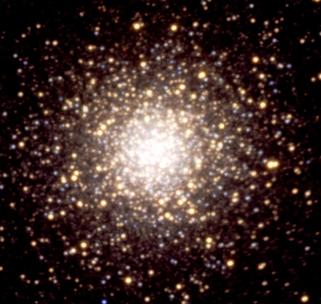Globular clusters, such as M3 pictured
above at optical wavelengthes
(Barbara Mochejska (Warsaw University), Andrew Szentgyorgyi (CfA),
FLWO) contain as many as one million gravitationally bound stars.
These high density clusters are ideal hunting grounds for
millisecond pulsar (MSP) searches, as globular clusters are known to
be populated by older stars, and MSPs are typically the oldest
pulsars. Read this NRAO press release
about the discovery of 21 new pulsars in another globular cluster
named Terzan 5 for a general description of pulsar search
techniques. McGill Pulsar Group member Jason Hessels and ex-member
Scott Ransom have also been responsible for the discovery of 14
additional MSPs in globular clusters, described in the following
publications:
-
A Radio Pulsar Spinning at 716 Hz. Jason W. T. Hessels, Scott
M. Ransom, Ingrid H. Stairs, Paulo C. C. Freire, Victoria M. Kaspi &
Fernando Camilo 2006, Science, 311, 1901
-
Twenty-One Millisecond Pulsars in Terzan 5 Using the Green Bank
Telescope. S. M. Ransom, J. W. T. Hessels, I. H. Stairs,
P. C. C. Freire, F. Camillo, V. M. Kaspi & D. L. Kaplan 2005,
Science, 307, 892
- A 20-cm Survey
for Pulsars in Globular Clusters using the GBT and Arecibo.
S. Ransom, J. Hessels, I. Stairs, V. Kaspi, P. Freire & D. Backer
2004, to be published in the proceedings of the "Binary Pulsars"
Conference, Aspen, January 2004 (astro-ph/0404213)
-
Green Bank Telescope Discovery of Two Binary Millisecond Pulsars in
the Globular Cluster M30. S. M. Ransom, I. H. Stairs,
D. C. Backer, L. J. Greenhill, C. G. Bassa, J. W. T. Hessels &
V. M. Kaspi 2004, ApJ, 604, 328
|
